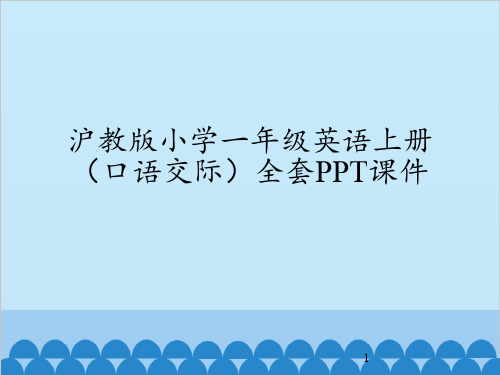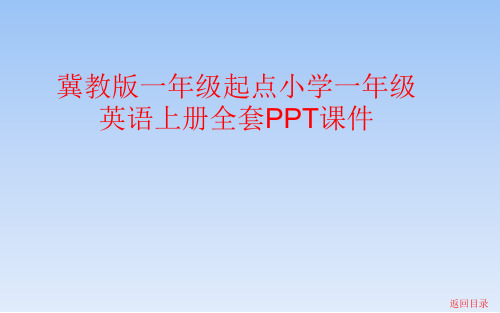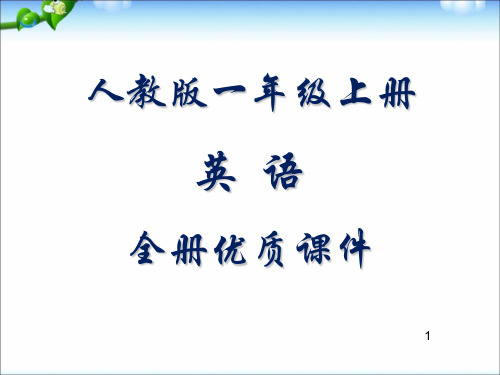小学一年级英语 ppt课件
牛津上海版小学英语一年级上册《Unit 1 On the farm》ppt课件

KEY WORDS
Vocation 职业; Vacation 休假
▪ welcome, vocational, glad, meet, look, class, read, study, after, after class,
▪ see, let, every, love, hard, thank, visit, time, English, want, desk, chair.
▪ 4. Do you see the red building next to the library?
▪ 你看见紧挨着图书馆的那栋红楼吗? ▪ next to… “邻接着,紧挨着”
▪ 教师办公室紧挨着我们的教室。 ▪ The teachers’ room is next to our
classroom. ▪ My company is next to a shopping mall.
Unit 1
Unit 2 Unit 3 Unit 4 Unit 5
Unit 6
Unit 7
Unit 8
Unit 9 Unit 10 Unit 11 Unit 12
Grammar Link verb "be"; there be Pronouns Nouns Numerals, Time Articles degrees of adj. and adv. verb tenses 1 categories of sentences verb tenses 2 prepositions object clauses adverbial clauses
▪ 2. Read the passage again. ▪ 3. Finish the workbook exercises P2 (1)
沪教版小学一年级英语上册(口语交际)全套PPT课件

Look and say eye nose
face mouth
Let’s play
老师说一句,同学们说 一句!要求反应要快!
T:This is my __e_y_e__. Ss:This is your __e_y_e__.
Let’s help Jack This is your …
小丑Jack的 脸又不见了,魔术 师加深了难度,这 一次的“魔语”是: This is your …, 请同学们正确使用 “魔语”,帮忙找 回小丑的脸!
Let’s help Jack
首先,让我们帮忙 找到Jack的眼睛!
This is your eye .
Let’s help Jack
然后,让我们帮忙 找到Jack的鼻子!
This is your nose .
Let’s help Jack
Let’s play!
Touch your face.
Touch your eye.
Touch your nose.
Touch your mouth.
Touch your ear.
Thank you.
136
Unit 3 My face
第二课时
Let’s revise new words!
Here you are.
Give me a rubber, please.
Here you are.
Give me a pencil, please.
Here you are.
Give me a book, please.
Here you are.
Give me ..., please. Here you are.
你好!我是懒羊羊。
冀教版一年级起点小学一年级英语上册全套PPT课件

Hello! Jenny! Hello! Li Ming! Hello! Danny! Hi! Hi! Hi!
返回目录
Presentation
I am Ms. Zhang. What’s your name? My name ...
返回目录
Presentation
冀教版一年级起点小学一年级 英语上册全套PPT课件
返回目录
目
录
课
题
001冀教版一年级起点小学一年级英语上册Unit 1 Hello and Goodbye-lesson 1
002冀教版一年级起点小学一年级英语上册Unit 1 Hello and Goodbye-lesson 2
003冀教版一年级起点小学一年级英语上册Unit 1 Hello and Goodbye-lesson 3
019冀教版一年级起点小学一年级英语上册Unit 4 Colours-lesson 19
020冀教版一年级起点小学一年级英语上册Unit 4 Colours-lesson 20
021冀教版一年级起点小学一年级英语上册Unit 4 Colours-lesson 21
022冀教版一年级起点小学一年级英语上册Unit 4 Colours-lesson 22
页码范围 3-17 18-28 29-39 40-51 52-64 65-78 79-90 91-105
106-121 122-148 149-160 161-176 177-191 192-207 208-226 227-241 242-257 258-276 277-290 291-323 324-338 339-357 358-373 374-396
人教版小学英语一年级上册全册精品课件

This is my Eraser.
This is my ruler.
This is my pen.
This is my pen cil .
This is my pencil box
This is my crayon.
boy
This is his pen。
girl
This is her pencil.
1. Read the words to your parents. 2. Chant the rhyme to your parents. 3. Chant your own rhyme to your parents.
Unit 2 Face Lesson 3
this is my bag. This is my pencil box
Touch your mouth
Look, listen and chant again
Homework
1. Read the words to your parents. 2. Chant the rhyme to your parents. 3. Chant your own rhyme to your parents.
小学英语(新起点)一年级上册 Unit 2 Face
Lesson 1
Look, listen and chant
Let’s learn
Let’s learn
Let’s learn
Let’s learn
Let’s learn
Look and say
Listen and do
Let’s do
afternoon 下午 Good afternoon!
下午好!
Good morning!I'm MissWu. What’s your name?
小学一年级英语课件

小学一年级英语课件1. IntroductionIn today’s world with globalization and internationalization, learning English at a young age has become increasingly important. As such, teaching English to young students has been included in most primary school curricula across the globe. This document aims at providing a basic outline for a first-grade English curriculum.2. ObjectivesThe objectives of teaching English to first-grade students are:•To help students acquire basic English language skills including listening, speaking, reading and writing.•To help students develop an interest and love for the English language.•To prepare students for future language learning.3. Course Outline3.1. Topic 1: Greetings and Introductions•Simple greetings (e.g. Hello, Good morning, etc.)•Introducing oneself (e.g. My name is…, I am ___ years old, etc.)•Basic questions and answers related to personal information.3.2. Topic 2: Numbers•Counting numbers from 1 to 10•Numbers in daily life (e.g. How many apples do you have?)•Understanding basic math vocabulary (e.g. plus, minus, equal, etc.)3.3. Topic 3: Colors and Shapes•Basic colors (e.g. red, blue, yellow, etc.)•Shapes and basic geometry vocabulary (e.g. circle, square, triangle, etc.)•Describing objects using colors and shapes.3.4. Topic 4: Family Members•Basic family members (e.g. mother, father, brother, sister, etc.)•Simple sentences describing family members (e.g. This is my mother.She is a teacher.)•Basic questions and answers related to family members.3.5. Topic 5: Action verbs•Basic action verbs (e.g. run, walk, jump, etc.)•Simple sentences using action verbs (e.g. I can run fast, She can jump high, etc.)•Describing daily activities using action verbs.3.6. Topic 6: Food and Drinks•Basic food and drink vocabulary (e.g. apple, banana, milk, etc.)•Simple sentences related to food and drinks (e.g. I like apples, She drinks milk for breakfast, etc.)•Basic questions and answers related to food and drinks.4. Teaching MethodologyTeaching English to young children requires a lot of patience, creativity and a variety of teaching methodologies. Keeping this in mind, the following methodologies may be used:•Songs and rhymes•Picture books and flashcards•Games and activities•Role plays and puppet shows•Audio-visual aids5. AssessmentAssessing young English learners requires a different kind of approach. Some of the methods that can be used include:•Observing students during class activities•Listening to students’ speaking and pronunciation skills•Looking through students’ written work and vocabulary retention•Conducting weekly or monthly quizzes and tests6. ConclusionTeaching English to first-grade students requires a lot of effort and dedication, but it can also be an enjoyable experience. With the curriculum and methodologies mentioned above, teachers can create an engaging and fun-filled learning environment for students. As students begin to acquire basic English language skills, they will also develop a lifelong interest in the language and an eagerness to learn more.。
- 1、下载文档前请自行甄别文档内容的完整性,平台不提供额外的编辑、内容补充、找答案等附加服务。
- 2、"仅部分预览"的文档,不可在线预览部分如存在完整性等问题,可反馈申请退款(可完整预览的文档不适用该条件!)。
- 3、如文档侵犯您的权益,请联系客服反馈,我们会尽快为您处理(人工客服工作时间:9:00-18:30)。
(自己英文名字) , (自己英文名字), what do you see?
畫個自己喜歡的東西, 別忘了幫他加上自己喜歡的顏色喔!!
I see a ___(顏色) (東西)___ looking at me.
現在請你開始動筆
I see a yellow duck looking at me.
Yellow duck, yellow duck, what do you see?
I see a blue horse looking at me.
Blue horse, blue horse, what do you see?
I see a monkey looking at me.
Monkey, monkey, what do you see?
I see children looking at me.
Children, children, what do you see?
你記得剛剛看過的動物嗎? 有哪些?
We see
Replay
• 再看一次?? • Yes • No
現在我們也來做一本屬於自己的書
• 首先我們先來看看這個網站
• 世界各地的小朋友在看完這本書之後,運用他 們的創意,創造出屬於他們自己的故事書…他 們的作品都存放在這個網頁裡…其中還有台 灣小朋友的作品喔!!
• 現在讓我們一起來看看他們的作品,相信你一 定可以做出比這些更好的作品,放在網路上…
I see a green frog looking at me.
Green frog, green frog, what do you see?
I see a purple cat looking at me.
Purple cat, purple cat, what do you see?
I see a white dog looking at me.
小学一年级英语
Brown Bear, Brown Bear, What Do You See?
by Bill Martin, Jr.
Ref.
Brown bear, brown bear, what do you see?
I see a red bird looking at me.
Red bird, red bird, what do you see?
a brown bear
a red bird
a yellow duck
a blue horse
a green frog
a black sheep
a goldfish
a purple cat
a white dog
looking at us.
That’s what we see.
and a monkey
White dog, white dog, what do you see?
I see a black sheelack sheep, what do you see?
I see a goldfish looking at me.
Goldfish, goldfish, what do you see?
